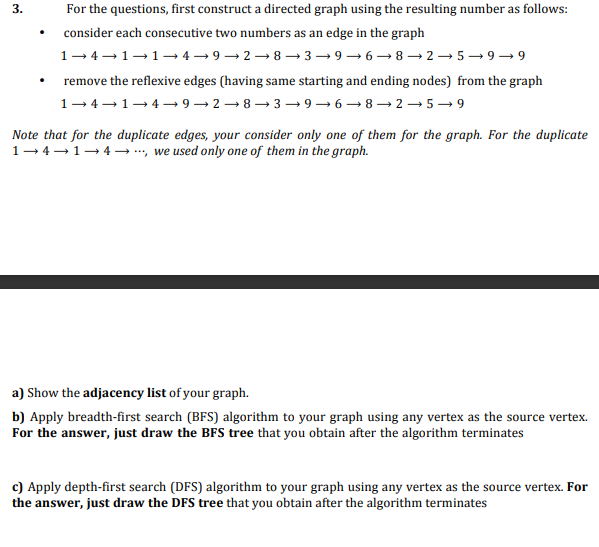For the questions, first construct a directed graph using the resulting number as foll consider each consecutive two numbers as an edge in the graph - 4-1-1-→ 4 → 9 – 2–8 → 3 →9 → 6→ 8 → 2 – 5-9–→ 9 remove the reflexive edges (having same starting and ending nodes) from the graph - 4- 1-→ 4 - 9 - 2 → 8 – 3 → 9 - 6 →8 – 2 → 5 → 9
For the questions, first construct a directed graph using the resulting number as foll consider each consecutive two numbers as an edge in the graph - 4-1-1-→ 4 → 9 – 2–8 → 3 →9 → 6→ 8 → 2 – 5-9–→ 9 remove the reflexive edges (having same starting and ending nodes) from the graph - 4- 1-→ 4 - 9 - 2 → 8 – 3 → 9 - 6 →8 – 2 → 5 → 9
Computer Networking: A Top-Down Approach (7th Edition)
7th Edition
ISBN:9780133594140
Author:James Kurose, Keith Ross
Publisher:James Kurose, Keith Ross
Chapter1: Computer Networks And The Internet
Section: Chapter Questions
Problem R1RQ: What is the difference between a host and an end system? List several different types of end...
Related questions
Question

Transcribed Image Text:3.
For the questions, first construct a directed graph using the resulting number as follows:
consider each consecutive two numbers as an edge in the graph
1-4-1-1– 4 → 9→ 2→ 8→ 3→9→ 6→ 8→ 2→ 5→9→ 9
remove the reflexive edges (having same starting and ending nodes) from the graph
1-4–1-4–→ 9→ 2→ 8→ 3 → 9 → 6 → 8→ 2 → 5– 9
Note that for the duplicate edges, your consider only one of them for the graph. For the duplicate
1-4-1-4 → …, we used only one of them in the graph.
a) Show the adjacency list of your graph.
b) Apply breadth-first search (BFS) algorithm to your graph using any vertex as the source vertex.
For the answer, just draw the BFS tree that you obtain after the algorithm terminates
c) Apply depth-first search (DFS) algorithm to your graph using any vertex as the source vertex. For
the answer, just draw the DFS tree that you obtain after the algorithm terminates
Expert Solution
This question has been solved!
Explore an expertly crafted, step-by-step solution for a thorough understanding of key concepts.
Step by step
Solved in 2 steps with 2 images

Recommended textbooks for you

Computer Networking: A Top-Down Approach (7th Edi…
Computer Engineering
ISBN:
9780133594140
Author:
James Kurose, Keith Ross
Publisher:
PEARSON

Computer Organization and Design MIPS Edition, Fi…
Computer Engineering
ISBN:
9780124077263
Author:
David A. Patterson, John L. Hennessy
Publisher:
Elsevier Science

Network+ Guide to Networks (MindTap Course List)
Computer Engineering
ISBN:
9781337569330
Author:
Jill West, Tamara Dean, Jean Andrews
Publisher:
Cengage Learning

Computer Networking: A Top-Down Approach (7th Edi…
Computer Engineering
ISBN:
9780133594140
Author:
James Kurose, Keith Ross
Publisher:
PEARSON

Computer Organization and Design MIPS Edition, Fi…
Computer Engineering
ISBN:
9780124077263
Author:
David A. Patterson, John L. Hennessy
Publisher:
Elsevier Science

Network+ Guide to Networks (MindTap Course List)
Computer Engineering
ISBN:
9781337569330
Author:
Jill West, Tamara Dean, Jean Andrews
Publisher:
Cengage Learning

Concepts of Database Management
Computer Engineering
ISBN:
9781337093422
Author:
Joy L. Starks, Philip J. Pratt, Mary Z. Last
Publisher:
Cengage Learning

Prelude to Programming
Computer Engineering
ISBN:
9780133750423
Author:
VENIT, Stewart
Publisher:
Pearson Education

Sc Business Data Communications and Networking, T…
Computer Engineering
ISBN:
9781119368830
Author:
FITZGERALD
Publisher:
WILEY